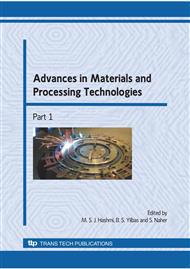p.1059
p.1069
p.1076
p.1084
p.1092
p.1099
p.1107
p.1113
p.1121
Effects of Grain Size on Micro Backward Extrusion of Copper
Abstract:
This study investigates the effects of grain size on the micro backward extrusion of copper cups. An equal channel angular extrusion (ECAE) technique was applied to refine the grain size in copper. Commercial available copper was annealed, deformed by six-pass ECAE at room temperature and then heat treated to obtain a microstructure with a grain size of about 4μm. Microstructure was examined and mechanical properties including hardness and stress-strain relationship were also investigated. The processed copper was then used in a micro backward extrusion of cups with the diameter of 3 mm and the wall thickness of 0.1 mm. The extruded cups were compared with those resulting from the coppers with larger grain size prepared by different heat treated processes. This study shows that the quality of the micro extruded cup increases as the grain size decreases. By using the refine-grained coppers for the micro backward extrusion, the cups with even rim height and uniform wall thickness can be easily produced.
Info:
Periodical:
Pages:
1092-1098
Citation:
Online since:
December 2009
Authors:
Price:
Сopyright:
© 2010 Trans Tech Publications Ltd. All Rights Reserved
Share:
Citation:


